X (Twitter) Marketing
How to create a Twitter marketing strategy for your brand
Looking to boost your brand’s presence on X (formerly Twitter)? This guide walks you through everything from auditing your account to increasing engagement.
Ready to put these tips into action? Start your free 30-day trial of Sprout Social and take your strategy to the next level.
Reading time 11 minutes
Published on October 27, 2025
Table of Contents
Summary
- X has evolved from a platform for personal thoughts to a powerful marketing tool with over 200 million monetizable users daily—now making it indispensable for brands.
- A successful X marketing strategy requires intentional planning, clear goals and a defined brand voice. Key steps in creating a X marketing strategy include auditing accounts, analyzing competitors' strategies, setting measurable goals and regularly comparing analytics to progress.
- Continued effective X marketing involves content calendaring, engaging with your audience through conversations and leveraging analytics to refine your X marketing strategy over time.
Twitter (also known as X) started out as a place for people to share their every thought. Now it’s turned into a powerful marketing platform that lets brands connect with their audience. Boasting 217 million monetizable users per day, it’s easy to see why companies keep using X after all of this time.
But it’s no longer enough to send out the occasional X post about a trending topic. Brands need to be more intentional with their social media marketing strategy on X. This will allow them to stand out and keep their audience engaged.
That’s exactly what we’ll discuss in this guide. Let’s take a look at the step-by-step process of creating a X marketing strategy to grow your presence and drive engagement.
What is Twitter marketing?
X marketing is the process of promoting your brand and its products or services through X. It involves establishing an effective social media marketing strategy to create and publish content on the platform. When you market on X, you need to publish the right X posts at the right time to attract the right audience.
But before you start posting, you need to consider the key elements of a successful X marketing strategy. Here’s a quick rundown:
- Audit your accounts. This will give you a baseline to work from.
- Check out your competitors’ strategies. Look at what their audience likes and consider their brand voice.
- Set clear, measurable goals. Be specific about what you want to achieve on X.
- Compare X analytics data to your goals on a regular basis to judge your progress.
- Establish your brand voice.
- Use a content calendar to help you develop and maintain a consistent content strategy.
It doesn’t stop with posting content. X marketing requires a plan to engage and interact with your audience. X is a conversation-based network. It’s important to create a two-way conversation with followers by replying to posts or direct messages.
In fact, you increase your chances of appearing in non-followers’ feeds by interacting with your audience’s replies and mentions. Doing this will improve your visibility as well as brand awareness. These are only a few of the many benefits of Twitter for brands.
Some X marketing strategies may include a plan to advertise on the platform. This involves delivering targeted ads or promoted posts to a relevant audience. We’ll get into the details of those later in this guide.
However you approach X marketing, make sure your strategy is aligned with your business goals and the style of the network. With that said, use these 13 tips to guide you through your X marketing strategy:
13 Twitter (X) marketing tips to influence your strategy
The following 13 X tips will give you a better understanding of the core parts of a good X strategy. But a great strategy requires knowing more than just the basics. Here you’ll find tips on how to shore up your X marketing strategy.
1. Strengthen your brand Twitter (X) profile
Your X business profile is your brand’s digital storefront. Every element, from header image to bio, shapes first impressions.
Your profile establishes credibility before prospects read a single X post. Optimize every component to reflect your brand’s value and personality.
Optimize these essential profile elements:
- Header image: Use high-quality visuals that showcase your brand’s current focus or key offerings
- Profile picture: Choose recognizable branding like your logo that appears consistently across all posts
- Bio optimization: Maximize your 160 characters with clear value propositions and relevant keywords
- Pinned X post: Feature your most important announcement, offer, or high-performing content
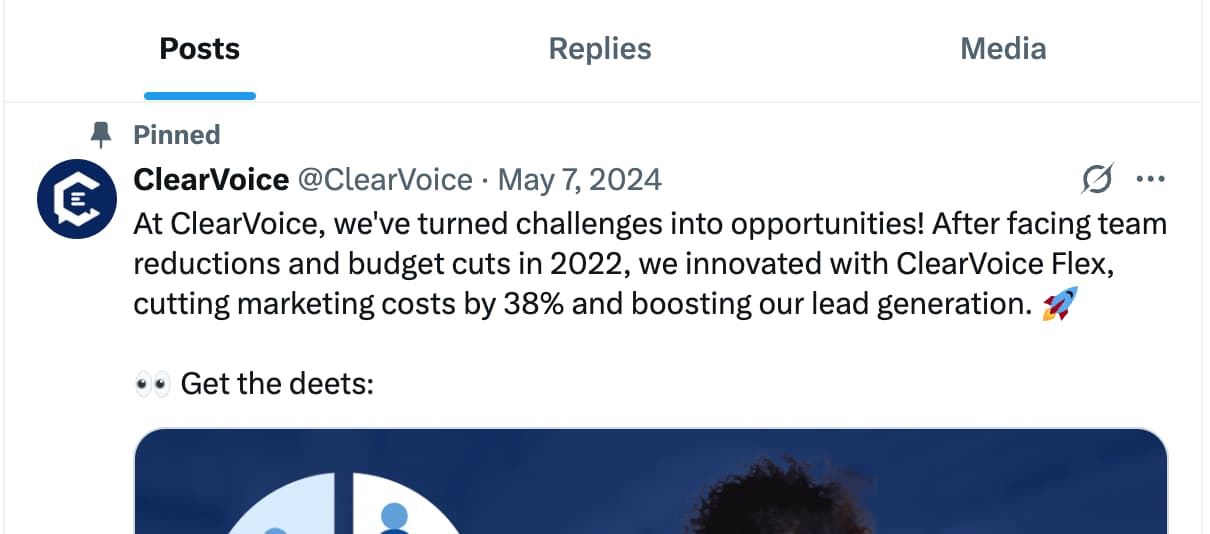
Source: X
2. Audit your Twitter (X) account
If you already have an existing X account, you should run a Twitter audit.
An in-depth review of your X analytics will allow you to take stock of what’s working and what’s not. You’ll want to know things like:
- Follower growth rate
- Whether you’re attracting your target audience
- How effective your posting frequency is
- What types of content are resonating best with your audience
X analytics tools like Sprout Social can do the hard part for you and help you analyze:
- Hashtag performance
- Individual X post performance
- Individual X audience
Knowing which posts are performing the best will give you an idea of the type of content that your audience is most interested in seeing. You can use this information to create a strategy to give your audience what they’re looking for in your content. This will ultimately allow you to maximize the reach and engagement you with your X posts.
One way to audit your X account is to look over your analytics manually from your Twitter Analytics dashboard. Access to the full native X analytics requires a subscription to X premium. And, it’s worth noting that X provides a more detailed analytics dashboard on desktop.
If you’re using Sprout Social to manage your X profile, you can access your X analytics alongside your other social media data in the Cross-Network Post Performance Report. Find your impressions, potential reach, engagements and engagement rate per impression for each of your X posts in this report.
3. Find your brand voice on Twitter (X)
Audiences on X are looking for brands that post authentically and stay true to their brand voice. It can be easy to jump on the latest trends to try to appeal to the masses on X. But don’t do this at the expense of losing your brand voice.
Your X presence can be more playful and casual than on LinkedIn or Facebook. However, it should still be authentic and consistent with your brand voice as a whole.
Wendy’s has nailed its brand voice on X. Going through the brand’s feed, you can immediately see the brand’s persona shine through. The brand voice is entertaining, honest and hilarious.

Source: X
Remember, an engaging brand voice is essential, but don’t jump on trends just for the sake of staying relevant. X users are especially astute when a brand is being inauthentic in an attempt to generate attention. In other words, don’t try too hard to fit in and instead, stay true to your brand voice.
4. Understanding the evolution to X and what it means for marketers
X’s transformation signals fundamental shifts in audience expectations and platform capabilities. Marketers must adapt strategies to leverage new features while maintaining authentic engagement.
Key strategic adaptations include:
- Enhanced verification: Leverage X Premium features for increased visibility and credibility
- Expanded character limits: Create more comprehensive content without relying solely on threads
- Advanced monetization: Explore creator revenue sharing and subscription features for brand partnerships
- Community building: Use X Spaces and Communities to foster deeper audience relationships
5. Use Twitter (X) hashtags and trends
Hashtags expand your content’s reach beyond your followers to engaged communities actively searching for specific topics. Strategic hashtag use connects your brand with trending conversations and relevant audiences.
Effective hashtag strategies combine branded campaign tags with trending topics and niche community hashtags. This approach builds awareness while establishing authority in your industry.
Some brands create Twitter hashtags for a specific campaign and use them in relevant posts. They may even encourage their audience to share X posts with that hashtag.
Tiffany & Co.’s collaboration with Netflix for the Frankenstein premiere is a great example of how brands can use hashtags strategically to boost visibility and engagement. The brand’s posts feature campaign-specific tags like #Frankenstein alongside core brand and community hashtags. This helps Tiffany connect its luxury identity to a trending entertainment moment—while naturally joining broader conversations happening on X.

Source: X
When brands blend their campaign hashtags with trending topics and niche community tags, they expand reach beyond their existing audience. They also make it easy for fans to join the conversation by sharing their own posts using the same hashtag. It’s a simple but effective way to increase participation and keep your campaign top of mind in relevant social spaces.
You will often see trending hashtags like this in your Explore tab. And, you can follow Twitter trending topics from the For you and Trending tabs.
6. Advanced Twitter (X) content formats that drive engagement
A winning strategy goes beyond single X posts. You need to leverage advanced formats to create richer, more immersive experiences for your audience.
Use Threads to tell a deeper story. They hook your audience and keep them scrolling, turning a fleeting impression into a sustained narrative.
For direct interaction, host a Space. These live audio conversations build authentic community and give your audience direct access to your brand’s experts. You can also foster dedicated groups of brand advocates with Communities. This format is perfect for creating a space for niche discussions and super-fans.
7. Run Twitter (X) ads for optimal reach
Using Twitter advertising is a great way to reach your audience in a more direct way than waiting for organic reach. Promoted posts can expand your reach more quickly.
They allow people to discover your profile, even if they don’t follow your brand or hashtags. When you use a promoted X posts, your posts show up on the timelines of people who share interests with your audience.
You pay a monthly fee as long as you want the promoted X post to stay up. Users can interact with promoted posts in the same way they interact with organic content. The only difference is that promoted X posts are labeled, so users transparently know it’s a paid ad.
X advertising is objective based, with your brand only paying for those actions which align with that goal. If your brand’s objective is reach, the recommended ad formats would be Promoted Posts (text, image, video), Carousel Ads, Video Ads (including vertical formats) and Timeline Takeovers. For this objective, you would pay for every 1,000 post impressions. And, you can set a cap on your CPM.
Here, Chipotle uses a promoted X post to advertise its Halloween deal for customers who visit one of its restaurants in costume.

Source: X
8. Post when your audience is most active
X’s real-time nature means content disappears from feeds within minutes. Strategic timing maximizes visibility and engagement when your audience is most active.
Research shows Tuesday through Friday between 9 AM and noon deliver peak engagement rates. Sprout Social’s ViralPost™ technology analyzes your specific audience activity patterns and automatically schedules posts for maximum impact.
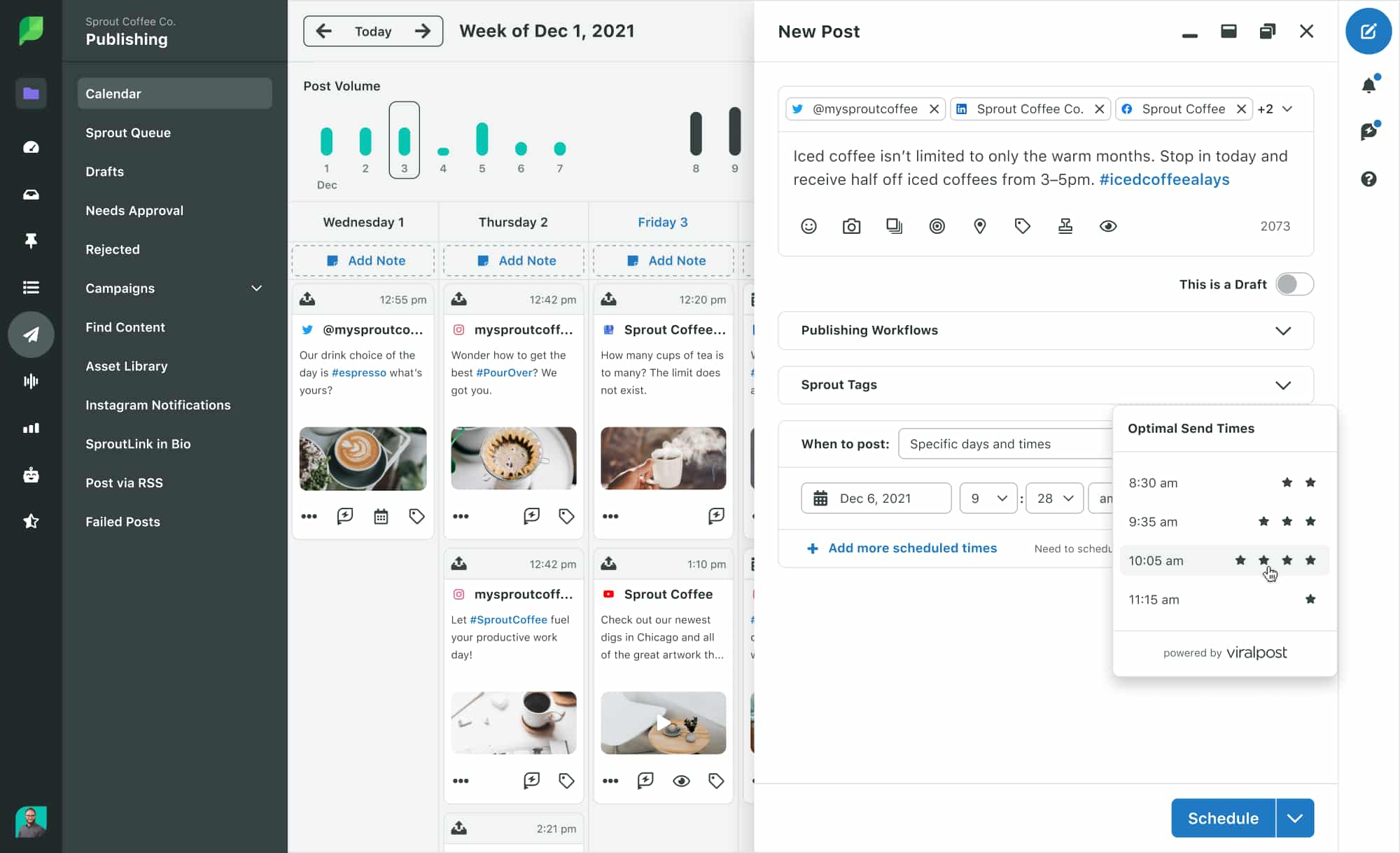
9. Maintain a content calendar and schedule X posts
The right X oists posted at the right time has the potential to generate massive engagement and virality. But you can’t wait for your audience to be active every time you send out a post.
Intentionally scheduling your posts ahead of time makes publishing more efficient. Knowing the right time to post makes scheduling a consistent flow of X posts much more manageable.
It’s important to be as consistent as possible on X. Best practices recommend posting at least once per day. Some brands post up to 15 times per day to stay in front of their audience.
Best practices can differ across industries. It depends on your resources and social media strategy to determine how frequently you can create and publish new content on X.
Use Sprout’s publishing tool to schedule your Tweets to go out at optimal send times. This allows you to schedule your posts for an entire week or month, making it easier to maintain consistency.
10. Engage with your Twitter (X) followers
X thrives on two-way conversations between brands and audiences. Create content that invites responses, shares, and meaningful interactions.
Proven engagement tactics include:
- Ask direct questions: Prompt followers to share opinions or experiences
- Run polls: Gather audience insights while driving participation
- Respond promptly: Reply to mentions and comments within 2-4 hours for maximum impact
- Join trending conversations: Add valuable perspectives to popular discussions in your industry
Make sure you’re engaging with people who are posting about your brand individually. If someone mentions your brand or responds to an X post, respond to their message in a timely fashion. It’s a good idea to have a dedicated community manager handle these requests.
At Sprout, we closely monitor any brand mentions and look for opportunities to engage. Whether it’s a question about student programs, a support-related problem or a positive mention, we make it a point to respond.

Another way to create engagement with your followers is to ask questions. You can do this by creating a survey on X directly or by just asking a question and Reposting people’s responses.
KFC ran a poll on X asking “Should we bring back potato wedges?” This wasn’t just a playful post; it was a way to tap directly into the voice of the customer. By framing the options around a highly debated, nostalgic menu item, KFC generated massive engagement while conducting valuable market research in real-time.
Source: X
Try out Sprout’s Suggested Replies feature
Sprout’s Suggested Replies feature can help simplify the process of responding to your audience. It lets you create canned responses for commonly asked questions on social media. Team members can then edit these with a personal touch.
These responses give the people managing the profile behind the scenes a simple way to handle any volume of inquiries they get on X.
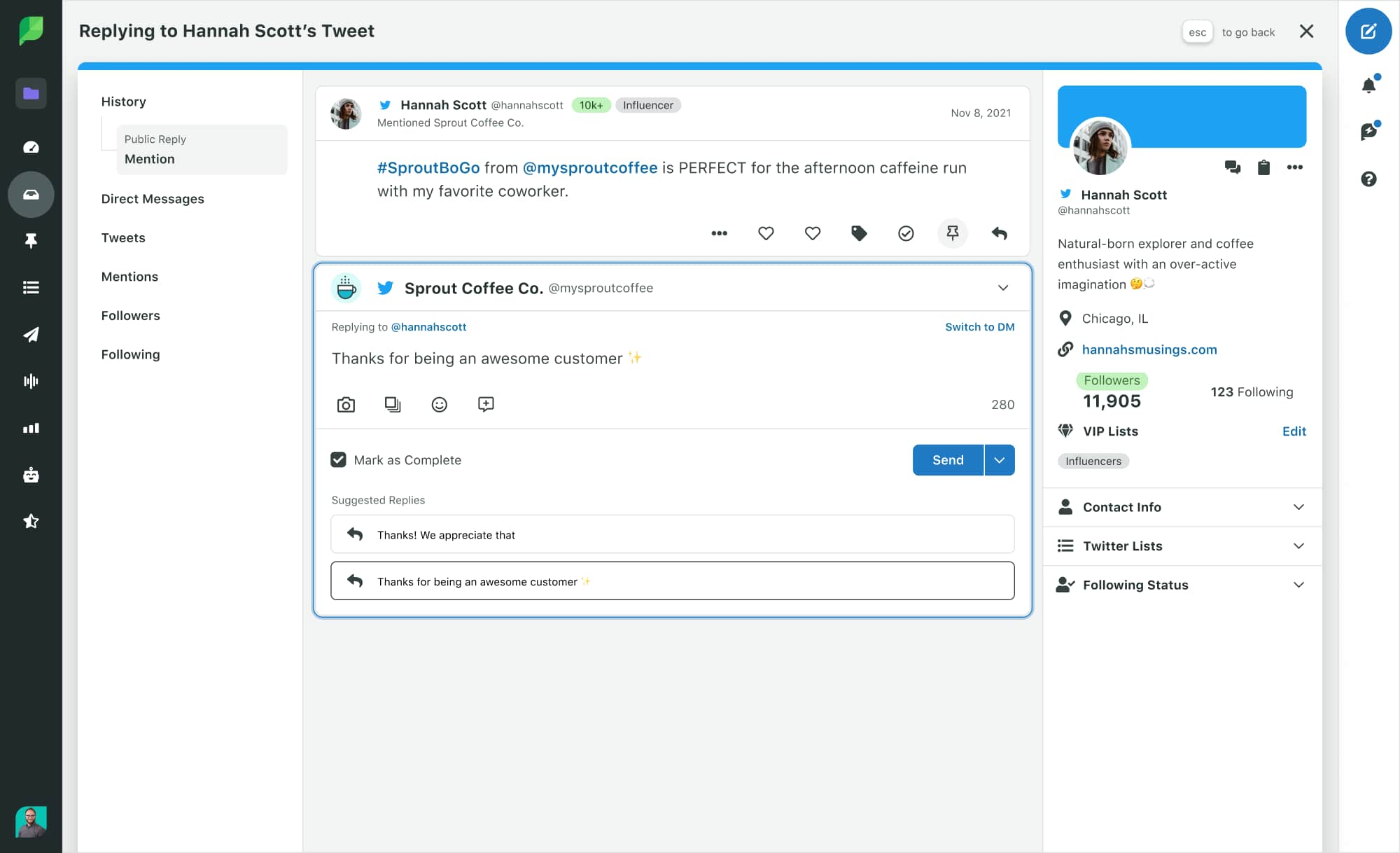
11. Twitter (X) crisis management and brand protection strategies
Real-time platforms demand proactive crisis preparation. Build comprehensive response protocols before issues arise to protect brand reputation and maintain audience trust.
Essential crisis management components:
- 24/7 monitoring: Use social listening tools to detect sentiment shifts and emerging issues
- Response hierarchy: Establish approval workflows for different crisis severity levels
- Content pause protocols: Create instant content freezes to prevent tone-deaf scheduled posts
- Template responses: Pre-approve holding statements for common crisis scenarios
Sprout Social’s Smart Inbox centralizes all mentions and messages, enabling rapid response coordination across team members during critical situations.
12. Set measurable Twitter (X) goals and track your analytics
Your X marketing strategy needs measurable goals that will keep your plan on track. Instead of publishing X posts and hoping for the best, set goals and objectives for X. These goals should help your business meet its overall marketing goals.
Goals for X can include:
- Building an engaged following to increase brand awareness
- Generating leads by directing traffic to an offer or email list
- Increasing traffic to your website by posting links to blog content
- Building brand loyalty by providing excellent customer service on X
- Networking with influencers and industry thought leaders to create more connections
Once you’ve determined your X goals, set aside time every month to measure those goals. Make sure you know which Twitter metrics to track for each goal. Then you can analyze what’s working with your strategy and what needs tweaking.
Native Twitter analytics will allow you to see your profile growth, and analyze your posts through metrics such as engagements, impressions, clicks, replies and Reposts. But a Twitter tool like Sprout can make the process nearly effortless. Once you’ve set your goals, you can implement them and track their progress within an all-in-one tool.
13. Analyze your competitors
Competitive analysis is great for keeping track of your competitors’ marketing efforts on X. What are your competitors posting? How often do they post?
To help you get answers, you can use Sprout’s Twitter Competitors Report. The X Competitors Report lets you track and compare the performance of other X profiles against the average of the profiles being compared.
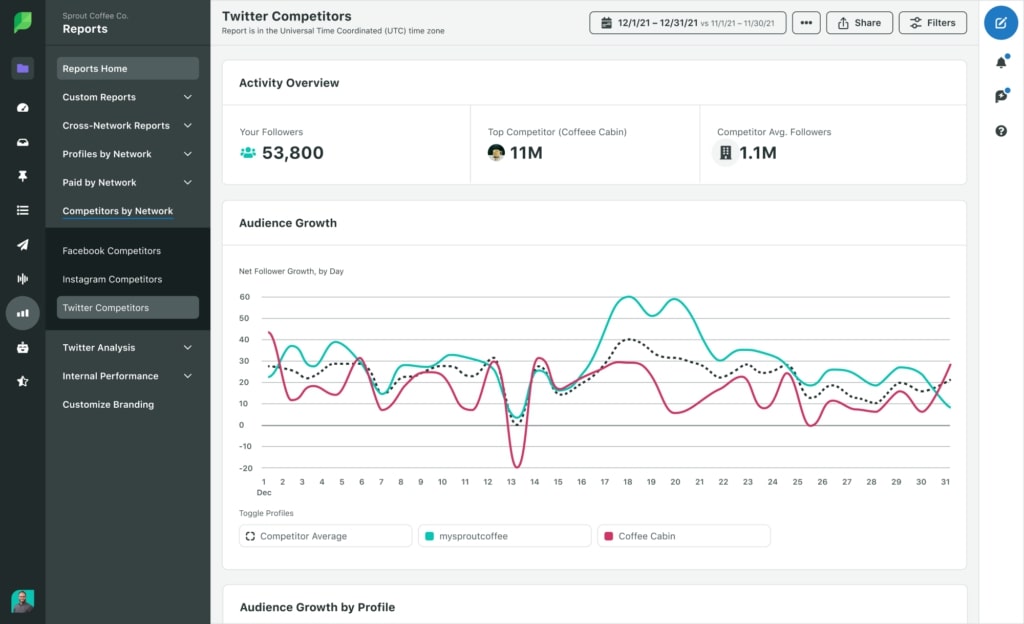
This information can help you shore up your own strategy by revealing areas where you can improve.
Unleash the power of Twitter (X) marketing
A solid X marketing strategy gives you leverage in a competitive market. It helps you stand apart from the crowd while keeping your audience engaged. More importantly, it enables you to stay top of mind for your audience.
Use the steps outlined above to get started with X marketing. And make sure to invest in a robust social media management platform like Sprout to make your job more efficient. Request a personalized demo to see how Sprout can help.
Use of Twitter nomenclature across Sprout refers to newly rebranded X platform and related terminology.
Twitter (X) marketing FAQs
How is Twitter used for marketing?
X marketing is the process of promoting your brand and its products or services through X. It involves a well-established social media marketing strategy to create and publish content on the platform.
Is Twitter still effective for marketing?
Yes, Twitter is still effective for marketing, especially when using available advertising features. Twitter advertising allows people to discover your profile, whether they follow you or not. You’ll grow your audience, generate leads, promote your business and much more with Twitter marketing.
What makes Twitter such a powerful marketing tool?
X remains highly valuable for marketers, with approximately 217 million daily active users including industry leaders, journalists and decision-makers. The platform’s real-time nature makes it ideal for brand awareness, customer service, and thought leadership.
How much does it cost to market on Twitter?
X marketing costs vary by approach. Organic marketing requires time and management tools, while paid advertising costs depend on your objectives and budget. Most businesses start with $50-500 monthly for promoted content.
Additional resources for X (Twitter) Marketing
How to create a Twitter marketing strategy for your brand
10 Twitter automation tools for your brand in 2025
14 Twitter tools to boost your brand’s marketing in 2025
How to use Twitter advanced search to get more leads for your brand
How to use Twitter communities to grow your brand
10 meaningful ways to get more Twitter followers
What is Twitter Spaces? – Bring your Twitter conversations to life with audio
17 Engaging ideas for what to post on Twitter
26 Twitter tips for beginners you’ll wish you knew sooner
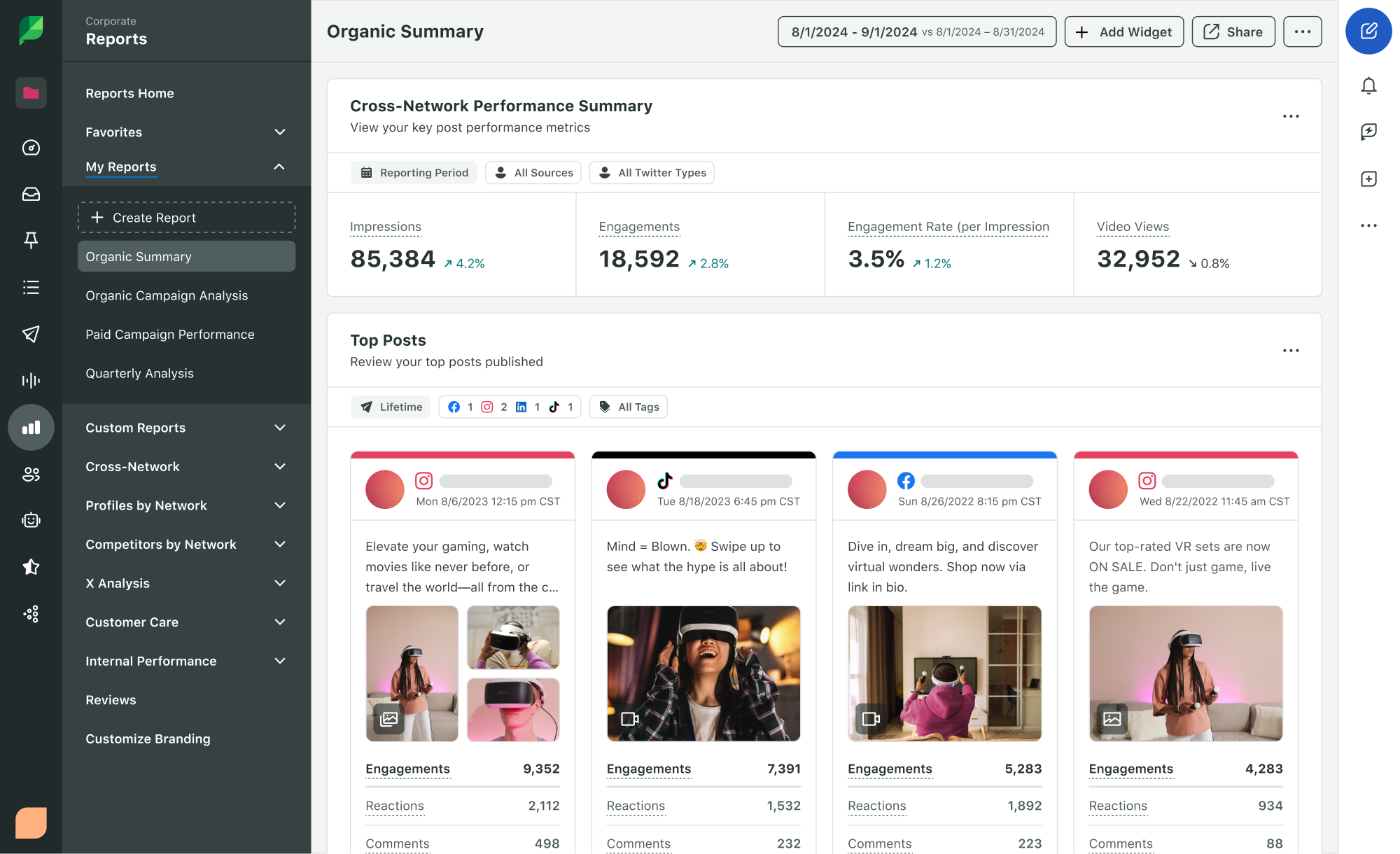
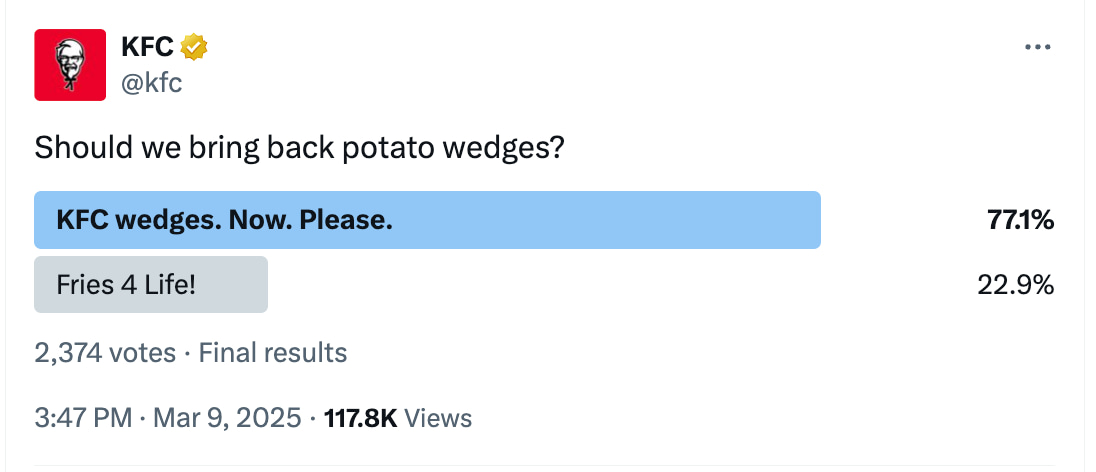











Share